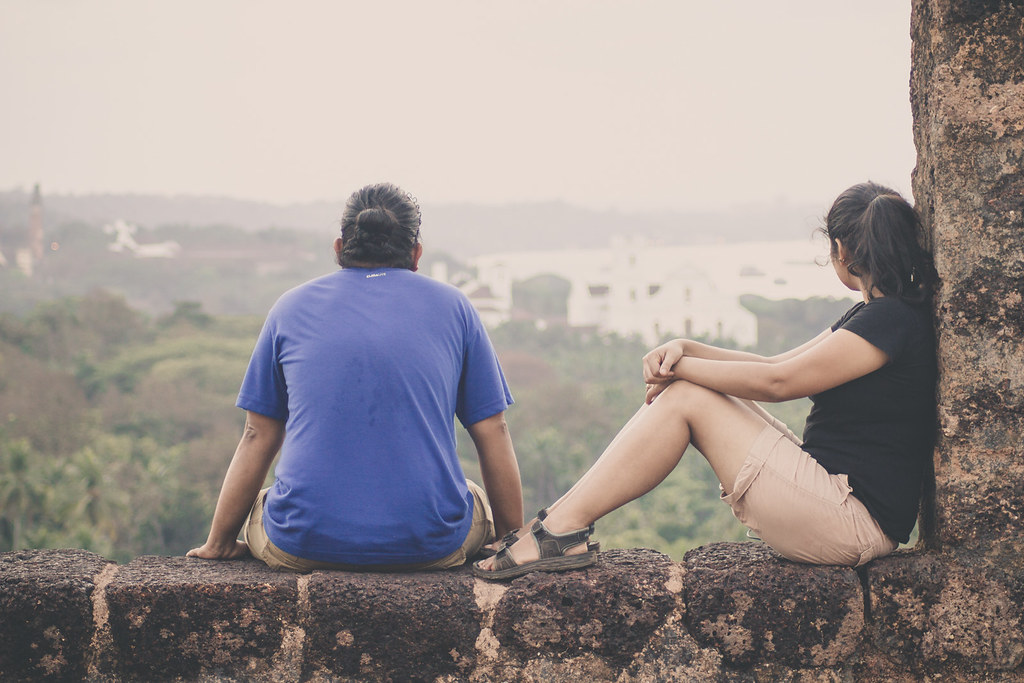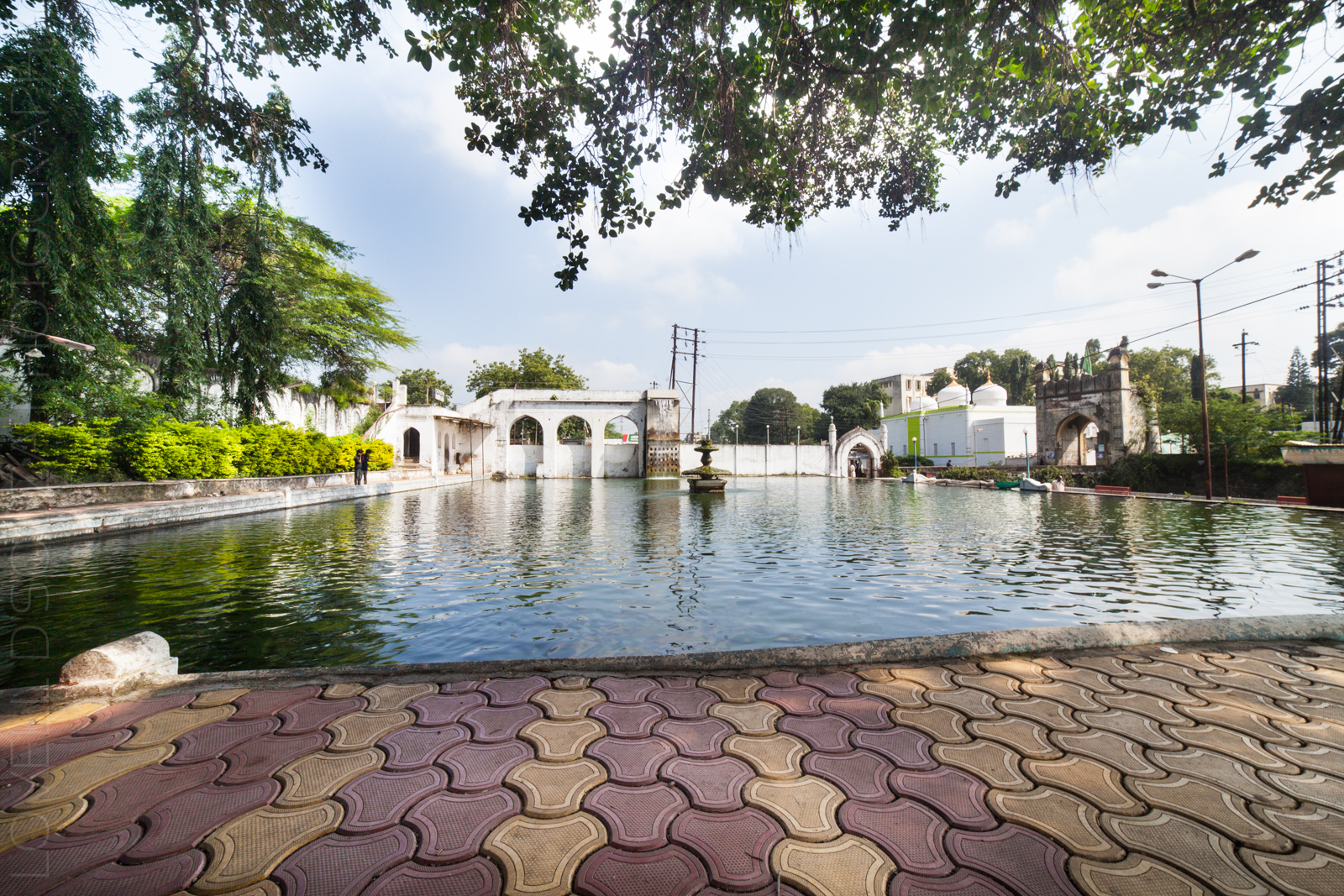After our adventures in Lonar, we were eager to make our way back home to Goa. But since Lonar was so far into the heartland of Maharashtra that going back home from there — relying solely on state transport buses — proved to be quite a task. Our only way back was Lonar → Aurangabad → Pune → Goa. But after the extremely exhausting first leg — 143 kilometres and five-hour-long commute from Lonar to Aurangabad — we decided we had to halt the night at Aurangabad to rest and preserve our sanity. And since we had never visited this city, we were determined to catch as many sights as we could in the morning before we boarded the bus.
[column size="two-third"][caption align="alignnone" width="1024"] Mahmood Darwaza, Aurangabad[/caption][/column]
Mahmood Darwaza, Aurangabad[/caption][/column]
[column size="one-third" last="true"]We had read about a fascinating spot called the Panchakki (Water Mill), which apparently, as its name suggests, is an ingenious structure dating back to the 17th century that used the energy of water to grind wheat to flour! Curious enough to see how it works, we walked around 2 kilometres from our lodging, which was very close to the state transport bus stand, to get to this place.
Aurangabad is a treasure trove of tiny surprises on every turn. Our walk revealed an insight into the fast-growing city, that wears the air of rapid development that all two-tier cities in the country sport, as they race to some invisible finish line of progress. Meanwhile, the ancient alter-ego of Aurangabad refuses to stop haunting you wherever you look. Time-worn, old buildings and structures, in varying stages of decay, stand as the mute testimonies of some other era, watching life and civilization speed past them.
Enjoying the sights that came from this paradox, we kept walking. We reached our destination to discover that the Panchakki itself is located in an unassuming part of the city, distinguishable as a tourist spot only in the fact that outside the structure stood the usual flock of persuasive and pesky auto-rickshaw drivers, waiting to hound unsuspecting tourists.[/column]
[caption align="alignnone" width="1024"] Panchakki[/caption]
Panchakki[/caption]
A walk inside, and you feel an immediate respite from the merciless Aurangabad heat, both physically and visually. A cool man-made water body lay in front of us. An educative plaque erected there reveals that this area was once the abode of the popular Hazrat Baba Shah Musafir, a Sufi saint. And this water mill was used to grind grain for the saint's disciples and pilgrims who visited this place, to which is attached, a dargah, a mosque and a madrassa.
[caption align="alignnone" width="1024"] Panchakki Reservoir[/caption]
Panchakki Reservoir[/caption]
[caption align="alignnone" width="1024"] Panchakki Reservoir[/caption]
Panchakki Reservoir[/caption]
While this water mill is no visual spectacle to look at, what will leave you awestruck is the engineering marvel of this system. Dating back to the 17th century (built in 1744 AD, it is said), this innovative water mill was designed to use the energy generated by flowing water from an underground channel — the source of which was a spring around 6 kilometres away to the north of the city. The entire water channel is made up of earthen pipes, which is then raised by a siphon to the top of the elevated, masonry pillar, from where it is made to fall with great force to the reservoir below. This force in turn, generates energy to to turn the large grinding stone adjacent to it, serving as a flour mill. For its absolute ingeniousness, it's quite impressive!
[caption align="alignnone" width="1024"] Panchakki - Aquaduct Plan[/caption]
Panchakki - Aquaduct Plan[/caption]
[caption align="alignnone" width="1024"] Water flowing into the Panchakki reservoir[/caption]
Water flowing into the Panchakki reservoir[/caption]
[column size="one-half"][caption align="alignnone" width="500"] Water propelled blades[/caption][/column]
Water propelled blades[/caption][/column]
[column size="one-half" last="true"][caption align="alignnone" width="500"] Grinder[/caption][/column]
Grinder[/caption][/column]
While the giant banyan tree overlooking the reservoir makes for a lovely, shady companion for resting travellers, schools of fish inside the tank give you blink-and-you-miss-em surprises. While tourists posed for pictures by the banyan tree, we sat down on an inviting bench to watch the proceedings.
[column size="one-third"][caption align="alignnone" width="340"] Panchakki[/caption][/column]
Panchakki[/caption][/column]
[column size="two-third" last="true"][caption align="alignnone" width="680"] Fish at the Panchakki reservoir[/caption][/column]
Fish at the Panchakki reservoir[/caption][/column]
We walked our way into the entrance of the mosque and dargah enclosure. While there’s not too much else to see in this place, which also happens to house the headquarters of the Wakf Board of Maharashtra, the stroll is pleasant enough for the sheer time warp experience it offers.
[column size="two-third"][caption align="alignnone" width="680"] Panchakki Mosque[/caption][/column]
Panchakki Mosque[/caption][/column]
[column size="one-third" last="true"][caption align="alignnone" width="340"] Panchakki[/caption][/column]
Panchakki[/caption][/column]
We see Baba Shah Musafir’s dargah (women not allowed), outside of which the chambers are cool and pleasant and time slows down to suit the mood. We even hello-ed a little parched and malnutritioned kitten resting in the shade, who we shared water with. We walked a little more and discovered a small one-room museum of sorts displaying arms, antiquities and artifacts from a time gone by.
[caption align="alignnone" width="1024"] Hazrat Baba Shah Musafir Dargah, Panchakki[/caption]
Hazrat Baba Shah Musafir Dargah, Panchakki[/caption]
[caption align="alignnone" width="1024"] Kitten outside the Dargah[/caption]
Kitten outside the Dargah[/caption]
[caption align="alignnone" width="1024"] Artifacts at the Panchakki museum[/caption]
Artifacts at the Panchakki museum[/caption]
The well-manicured gardens with towering trees, cool shade and multiple ornamental water tanks and fountains add to the Panchakki’s Mughlai appeal. A tiny bubble of old world charm in a dusty, developing city.
[caption align="alignnone" width="1024"] Water tank at Panchakki[/caption]
Water tank at Panchakki[/caption]
[caption align="alignnone" width="1024"] Water tank at Panchakki[/caption][hr]
Water tank at Panchakki[/caption][hr]


 Mahmood Darwaza, Aurangabad[/caption][/column]
Mahmood Darwaza, Aurangabad[/caption][/column] Panchakki[/caption]
Panchakki[/caption]
 Panchakki Reservoir[/caption]
Panchakki Reservoir[/caption] Panchakki - Aquaduct Plan[/caption]
Panchakki - Aquaduct Plan[/caption] Water flowing into the Panchakki reservoir[/caption]
Water flowing into the Panchakki reservoir[/caption] Water propelled blades[/caption][/column]
Water propelled blades[/caption][/column] Grinder[/caption][/column]
Grinder[/caption][/column] Panchakki[/caption][/column]
Panchakki[/caption][/column] Fish at the Panchakki reservoir[/caption][/column]
Fish at the Panchakki reservoir[/caption][/column]


 Kitten outside the Dargah[/caption]
Kitten outside the Dargah[/caption]
 Water tank at Panchakki[/caption]
Water tank at Panchakki[/caption]

Share the love
If you liked what you just read, share it with your friends, family, dentist, parish priest, bookie and CA.